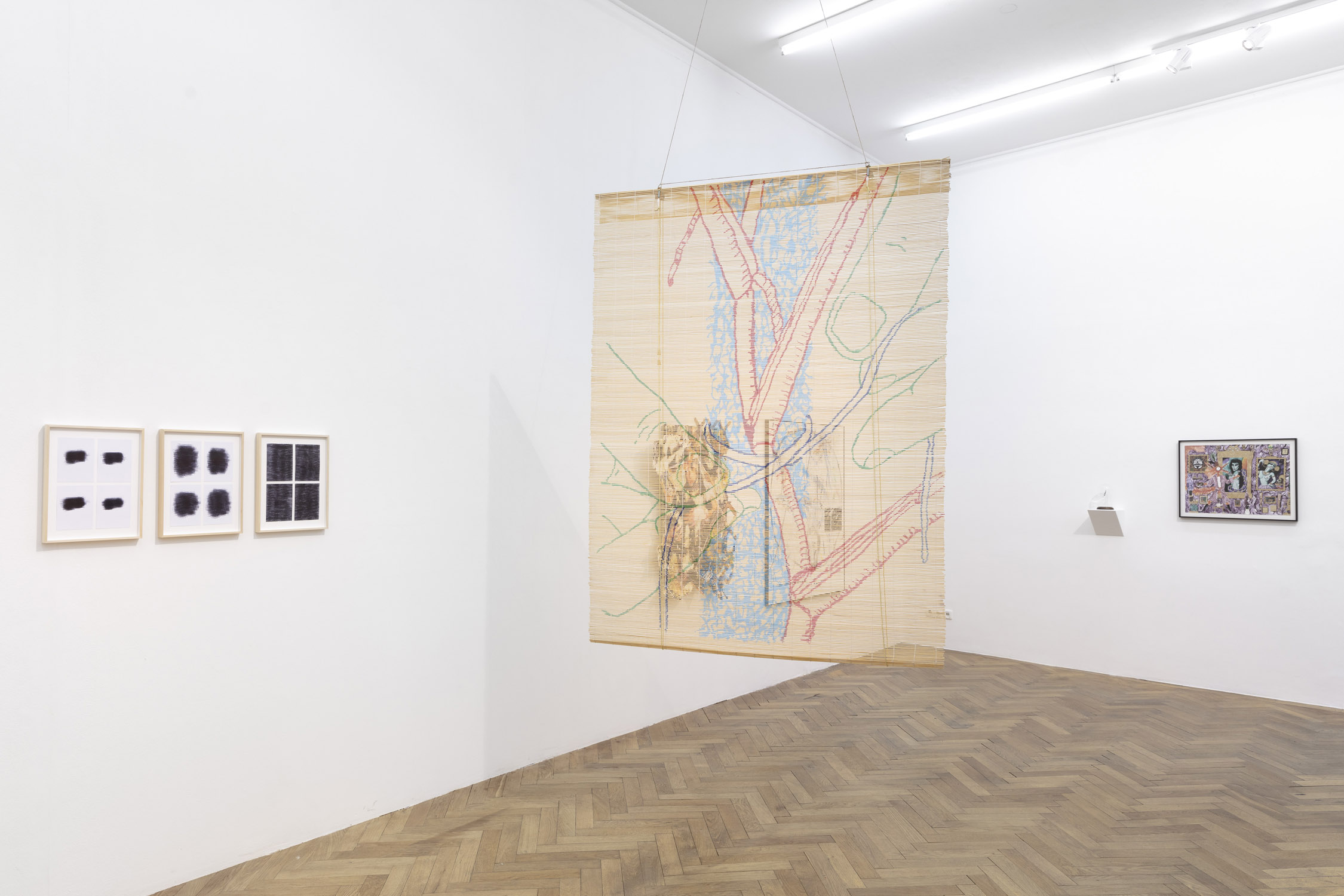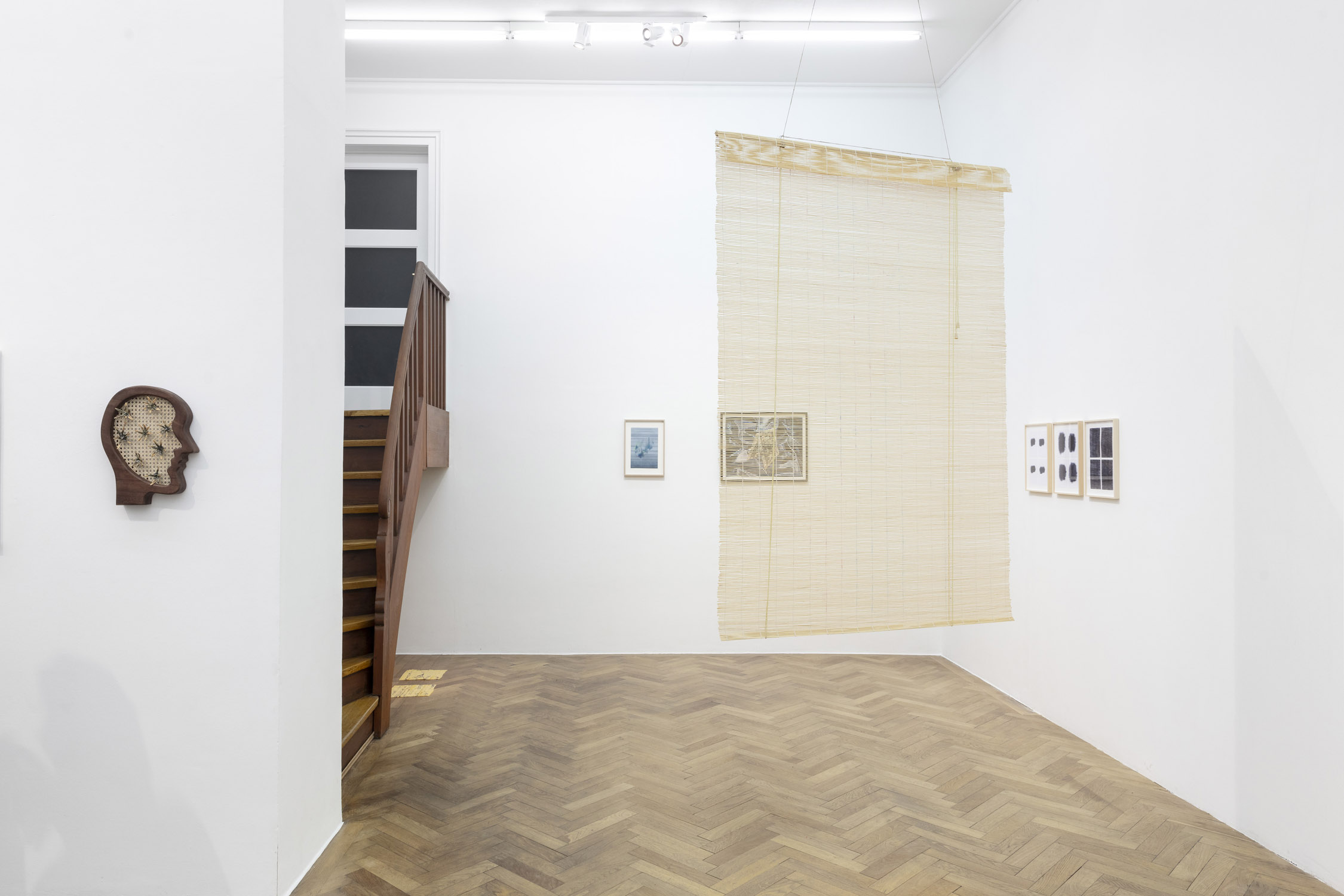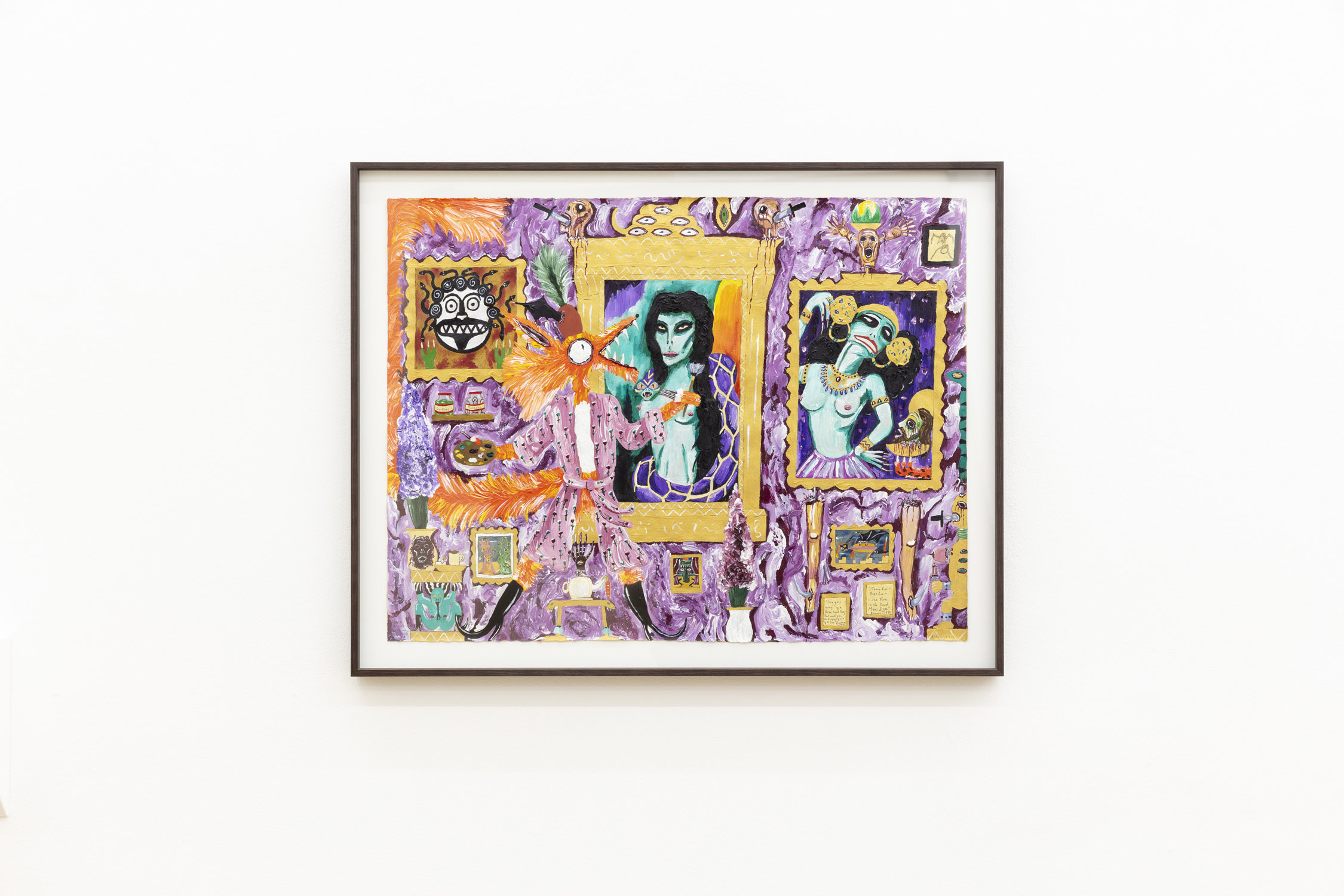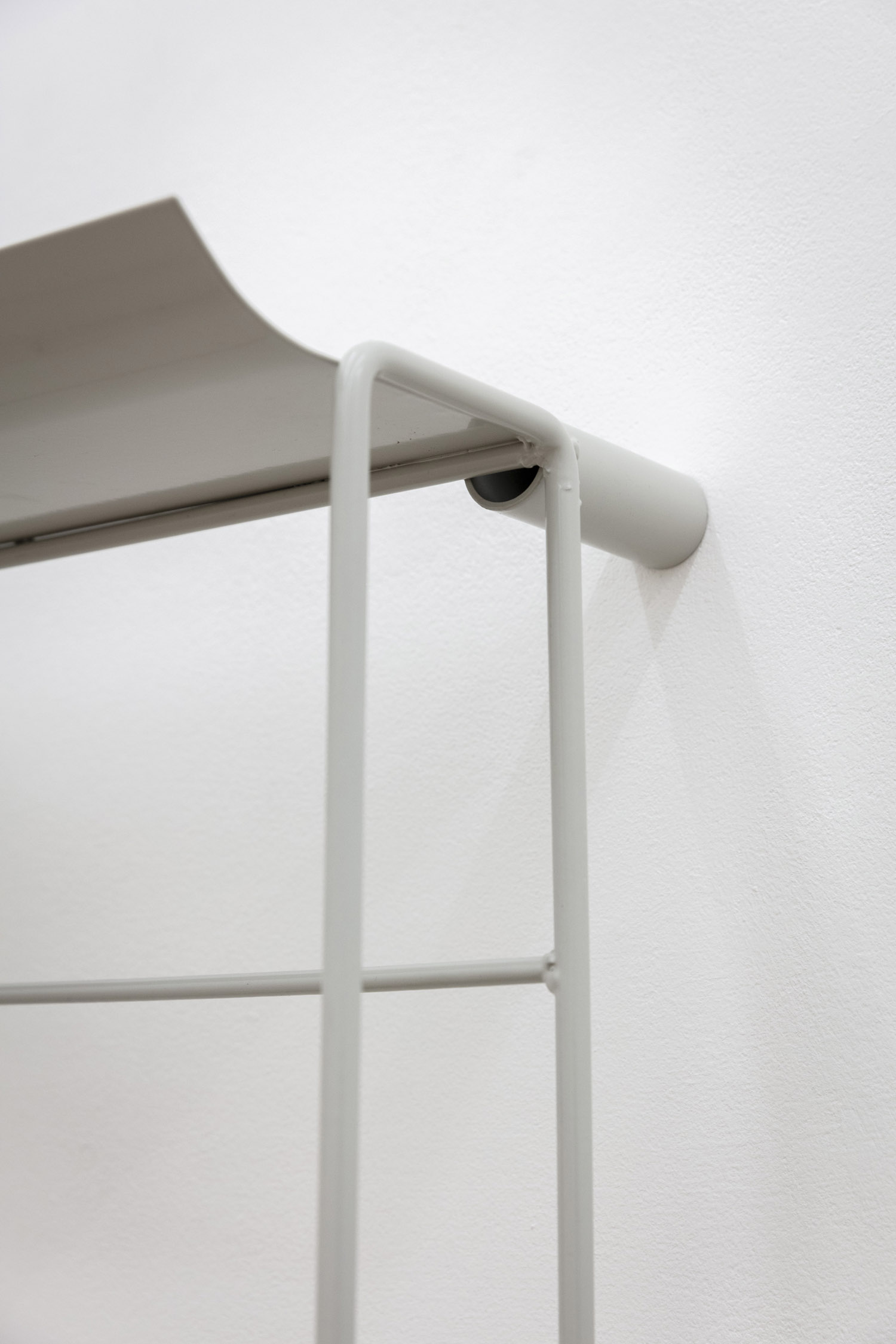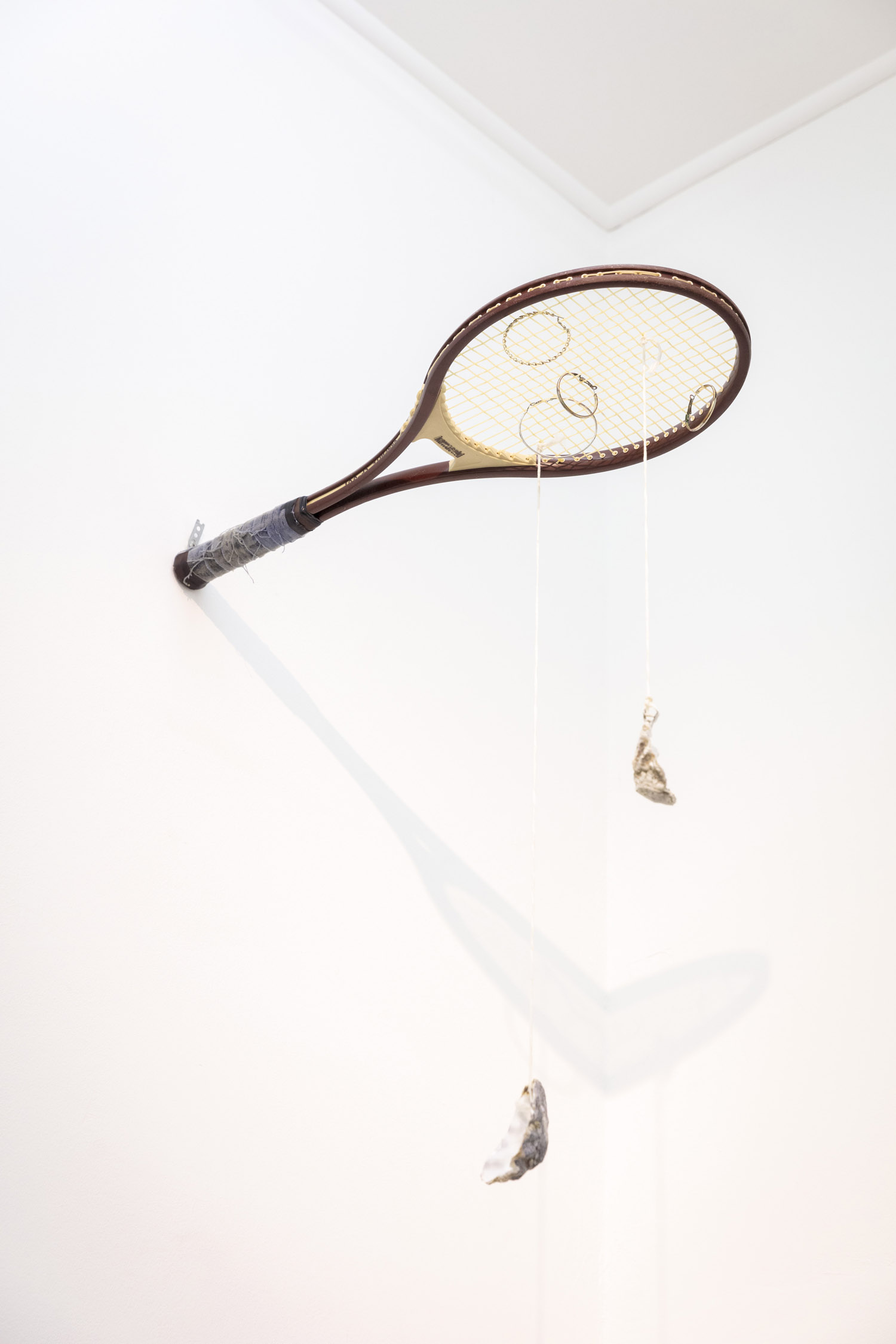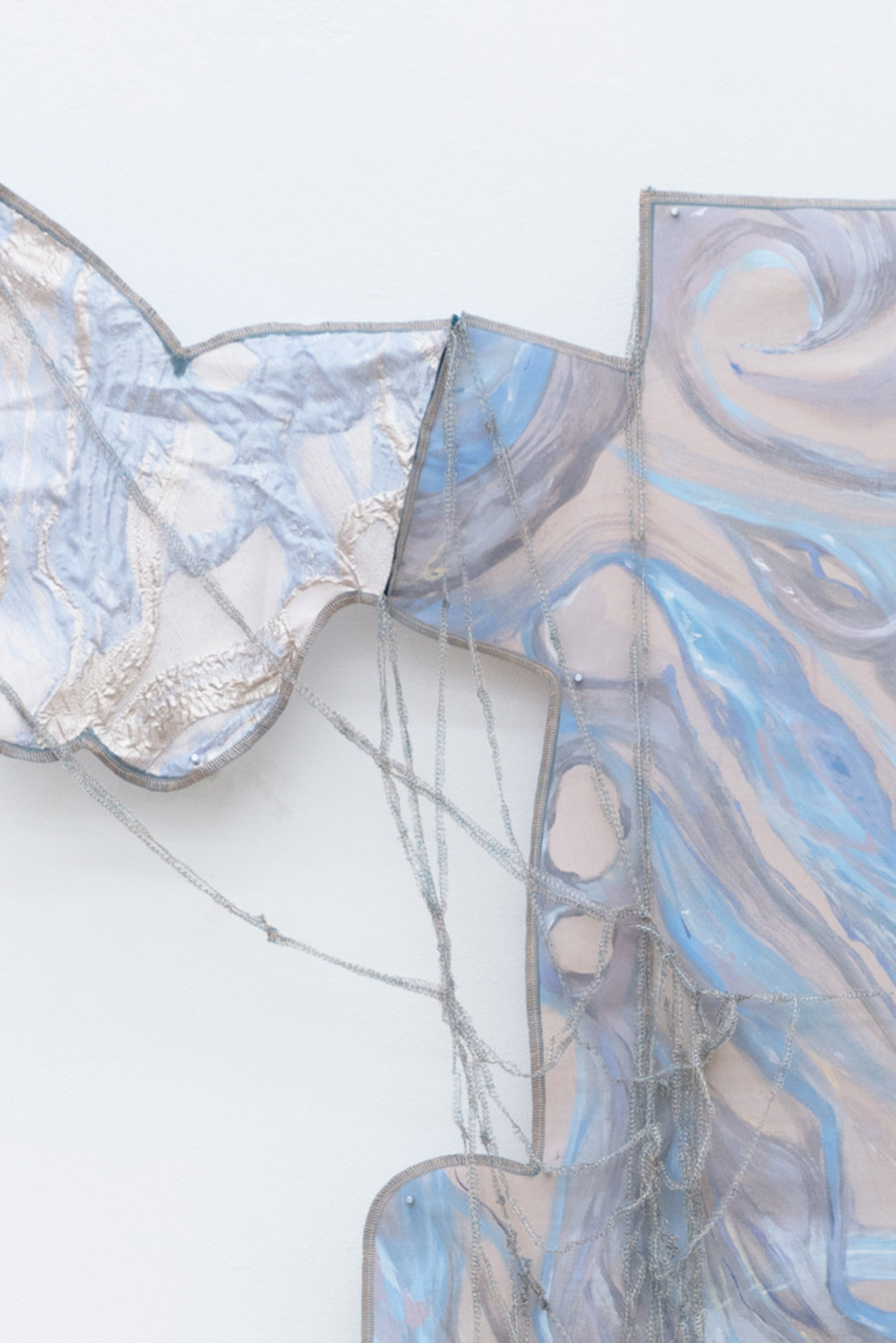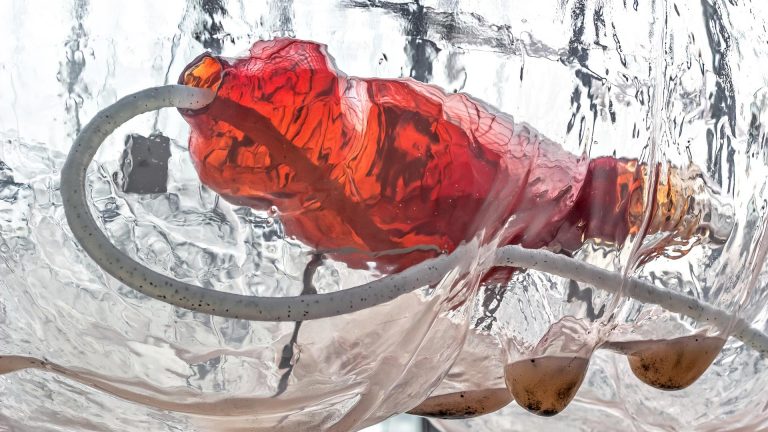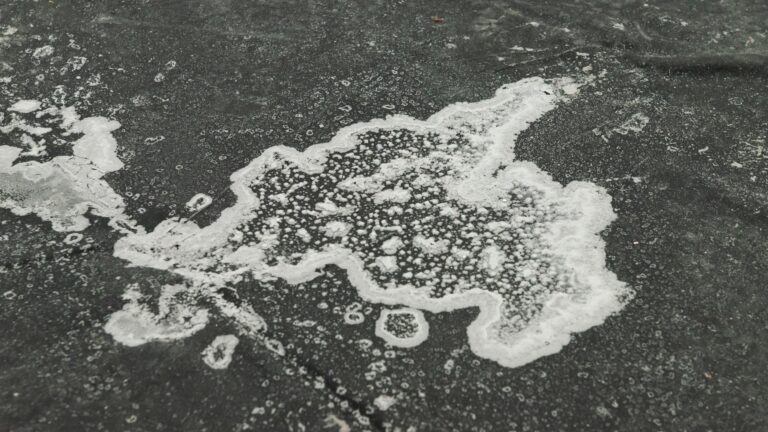Artists: Michaël Van den Abeele, Ana Navas, Olga Balema, Anna McCarthy, Siro Cugusi, Veronika Hilger, Michael Dean, Anousha Payne, Andrew Gilbert, Tessa Farmer, Monsieur Zohore, Malte Zenses, Donja Nasseri, Anna Vogel, Sergio Rojas Chaves, Thomas Geiger
Exhibition title: Two To Tango (3)
Venue: Sperling, Munich, Germany
Date: February 23 – April 6, 2024
Photography: ©the artists. Courtesy of SPERLING, Munich. Photos by Sebastian Kissel
Two To Tango is an exhibition series by Sperling in which each gallery artist is asked to invite one guest artist to participate in a group show. This is the third physical iteration of this format after 2017 and 2019, and in 2021 Kristian Vistrup Madsen wrote an essay-style version of TTT for Sperling’s online magazine Volumes.
Ana Navas invited Michaël Van den Abeele, whose bed sculptures she saw last autumn at April in Paris in Amsterdam. Interested in the migration of forms, the decontextualization of design objects she loved his bed sculptures out of different materials, the one coming to Munich a small powder coated steel bed reminiscent of a design by Carlo Mollino. For the artist, every bed is first a structural negotiation between the body and an uneven earth. They come in various sizes of society: single, double, doubter (in Flanders there’s an in between size bed called doubter). Like with Ana Navas’ Costumes and Dress-Ups sculptures of objects like e.g. a backless booster car seat, the bed is thought in the relation to a body, but the human body is several degrees removed. What remains from a design here?
We asked Anna McCarthy why she invited Olga Balema and what she appreciated about her work, besides the shared interest in installation and sculpture using a variety of materials to explore concepts of space, presence, and absence in their own way. Anna’s text back read as follows: “Olga was an apparition, a dead ringer for a postcard on my kitchen wall. Once, she slept in my bed, drank from my cups and then she disappeared into the fog. Her work is real daredevilry and funny as hell.” The minimalistic sculptures by Olga Balema in TTT, titled Formula, consist of foam and latex and like often in her work simultaneously delineate the limits of sculpture while opening up its possibilities.
As an artist in the traditional media of oil and ceramics, Veronika Hilger is also closely connected to the digital world. It’s probably no coincidence that a few years ago she came across Siro Cugusi, a painter living in Sardinia who, like her, works at the open heart of what painting is in the Instagram age. He plays with opacity, different styles and genres that seemingly cannot be pinned down to a single meaning. The combination of his Philip Guston-esque pink portraits and landscapes with her paper-clay hooks is a deep dive into symbolism.
Anousha Payne is the latest addition to the gallery roster and before her first solo show in spring 2024 she will participate in Two To Tango (3) with one of her signature sculptures using ceramics, wood and rattan. She invited fellow London artist Michael Dean – internationally known for his innovative approach to installation art using readily available materials. His works on paper are as fascinating, as they manage to preserve the qualities of his sculptural work using “democratic” color carriers like a lipstick (which is more likely to be carried around than a color pencil nowadays). Integrating their writing into their practice is another link between these two, be it through the deformation of writing into new typographies (Dean) or referencing folk tales and her own stories in ceramics and painting (Payne).
Last year Malte and Monsieur Zohore appeared in an Instagram story, and it must have created FOMO in everyone who saw it due to the cool vibes. Then in autumn during Paris Internationale we met Monsieur Zohore outside the fair, his trousers ripped and bandages on one leg. The bicycle crash he had suffered a couple hours before was benign fortunately, and he continued his art tour de force looking like he had just stepped off some Paris runway. Malte and Monsieur Zohore have known each other since 2013, and their practices are strangely intertwined. They both work with pop- and subcultures, pursuing printmaking as an important practice while using analog and digital archives, seemingly outgoing introverts wandering their own minds and creating ever-expanding pieces of unsolvable puzzles.
Andrew Gilbert met Tessa Farmer while they were both installing the Reimagining the Victorians exhibition at Nottingham Lakeside Arts in September 2023. Although Andrew had seen her work before, he couldn’t recall where. He was immediately fascinated by the obsessive and minute detail in her work. Her use of preserved dead animals, such as squirrels, frogs, birds, and foxes to depict stories of violent occupation and invasion by foreign armies, immediately resonated with Andrew. Her installations reminded him of the European museum’s death cult mentality and style of presentation, categorizing and preserving specimens from exterminated species and peoples.
Anna Vogel and Donja Nasseri have been collaborators, friends, teacher and scholar to each other. They are both descendants of the Düsseldorf academy and part of a unique network of artists that can only be found in this agglomeration of cities that can feel both too small and too big, too far and too close: the Rhineland. Both artists have a keen eye for aesthetics, particularly post-industrial landscapes and patterns, which they capture in small or medium-sized frames even though Donja’s work often expands into the space and fills entire rooms with prints and wallpapers. For TTT, they both contribute photography-based work, thus aligning their practice to a comparable level.
According to Thomas Geiger, Sergio Rojas Chaves possesses a remarkable talent for prompting a shift in perspective in his art presenting a view on the world from a plant or animal point of view. Geiger and Chaves first met in 2018 during Geiger’s Festival of Minimal Actions at Despacio in San José (Costa Rica). During the festival, Thomas performed Sergio’s Houseplants on Tour, which involved taking a stroll around the neighborhood with houseplants. They have remained in contact ever since and have collaborated on several occasions. For TTT Sergio is contributing bamboo curtains with painted houseplants that reflect humorously on the way in which contemporary societies try to connect to nature.
Olga Balema (*1984 in Lviv, UA) is a Ukrainian-born American artist and sculptor. One of the major concerns of her work is form, another material, another is paying attention to where and how things go into a space. Sometimes her work can be called site respondent, other times it responds only to itself. Formal integrity and rigor are at the core of her process and meaning emerges gradually. The sculpture develops through self-referentiality and visual association: a particular aspect of one work might reappear and be reworked in the next one. Outer edges – the way they’re constructed, layered over with varied materials, heat-sealed, broken, and glued again – may, for example, become the basis for a future body of work.
Sergio Rojas Chaves’s (*1992 San Cristobal, VE, lives and works between Basel, CH and San Jose, CR) work focuses on contemporary depictions of animals and of plants and affective approaches to biology. It is through this exploration of the role of non-human organisms in our day to day that he attempts to cast new light on the human condition and our interconnected relationships with the natural world. This interest in the way in which we interact with plants and animals has led him to observe birdwatching communities or to study people’s relationships to their house plants with a sort of ethnographic approach that allows him to dig deeper into these relationships.
It is the in-between places that appeal to Italian artist Siro Cugusi (*1980, Sardinia, IT), the fluid spaces where dreamscape meets reality and rationality steps aside. His paintings and sculptures tread a fine line between the figurative and the abstract, characterized by layers of information in different media and suggestions of recognizable forms. Cugusi explains that artists are like alchemists, so as an artist he tries to find the right compromise, the correct equilibrium and order, a sort of balance of elements. He completed his MFA in 2004 at the Academy of Fine Arts in Sassari, Italy. A forager of ideas and feelings, he collects notes, photos, and sketches of memories, which then feed into his work, using an array of different materials including oils, enamel, acrylics, spray paint, marker, pencil, and oil wax pastel. Formal design elements such as lines and shapes are often expressed in fleshy, chewing gum pink reminiscent of Philip Guston. In his sculptures, meanwhile, bulbous elements give the impression of a growing, natural mass.
Tessa Farmer (*1978, Birmingham, GB) is an artist based in London. Her work, made from insect carcasses, plant roots and other found natural materials, comprises hanging installations depicting Boschian battles between insects and tiny winged skeletal humanoids. She is the great granddaughter of the influential writer of supernatural horror Arthur Machen. Her tiny spectacles resound with a theurgist exotica: their specimen forms borrow from Victorian occultism to evolve as something alien and futuristic: “Playing out apocalyptic narratives of a microscopic underworld, Tessa’s manikin wonders rule with baneful fervour: harnessing mayflies, battling honeybees, attacking spindly spiders. Presented as wee preternatural discoveries, Tessa’s sculptures conjure a superstitious premise, dismantling the mythos of fantasia with evidence of something much more gothic, sinister, and bewitching.” (Patricia Ellis)
Michael Dean (*1977 in Newcastle Upon Tyne, GB) initiates his artistic process with his personal writings, transforming textual elements into sculptures and immersive installations that delve into themes of language, the body, and intimacy. In many of his works, Michael Dean develops a sculptural script within a space. However, his objects, which are frequently made of materials like cement, sand, and earth, don’t necessarily depict specific letters. Rather, they are to be seen as an abstract semiotic system that generates meaning via a process of interaction — like words in a sentence. His materials are readily available and include concrete and steel reinforcement bars. His sculptures are exposed to the elements as he works on them outdoors.
Monsieur Zohore (*1993 in Potomac, MD) is an Ivorian-American artist based in New York. His practice is invested in the consumption and digestion of culture through the conflation of domestic quotidian labor and art production. Through performance, installation, and sculpture, his practices explore queer history alongside his Ivorian-American heritage through a multi-faceted lens of humor, economics, art history, and labor. The artist’s work incorporates multifarious materials and objects as part of lively engagements with pop culture. Zohore’s paper towel works make use of Bounty Paper Towels and bleach.
Donja Nasseri’s (*1990, Düsseldorf, DE) work combines photography, objects, video, and language to a collaged unity. As the German-born daughter of an Afghan father and an Egyptian-German mother, she has a sharp view of the diversity of possible narrations and the truths associated with them. The changes in tradition, culture and (gender) identity make up the conceptual core of Donja Nasseri’s oeuvre, which is primarily based on photography as a “carrier of memories”, as a medium of documentation and fictional manipulation with all digital and analog collage techniques. Nasseri stages her motifs by drawing on historical and personal stories. In multilayered work processes, she constructs analog collages of pictures featuring historical objects, scratched negatives, and transparent foils that in the end are captured using “classic” photography.
Anousha Payne (*1991) lives and works in London. She graduated from Camberwell College of Arts with a BFA in 2014. Working with sculpture and painting, her preferred materials are ceramics, textile, wood, rattan, metal and watercolour. Payne’s work explores the human pursuit of spirituality in object form, as a mode of cultural expression that is distinct from religious symbolism. Her work processes the boundaries between personal experience, fiction and myth; exploring how information is both lost and gained through the transition from drawing and painting into three-dimensional works, notably ceramic sculpture. Often deploying reptile skin, her ceramics are intended as hybrid objects, a reminder of the fluidity and shared qualities between humans, animals, the natural world and inanimate objects. Ceramic sculptures are adorned with jewellery and textiles, acting as cultural signifiers whilst questioning material hierarchies and values. This process seeks to build an aesthetic dialogue and personal visual language as a meditative interaction. Informed by Indian folkloric stories and personal fiction, it plays on ideas of the performative powers of objects and chance; the combination of moral dilemmas and magic alongside characters with transformative qualities. A recurring theme in her work is highlighting the incongruity between ancient materiality and modern technology.
Michaël Van den Abeele, *1974, lives and works in Brussels, Belgium. Often in his work, various figures of domesticity are used as site of desire and deficit. Another recurring theme or action is the transformation (either as émancipation or decadence) of the technical into ornamental. This and other motives of consumption, digestion and resurrection bring back the classic theme of eros and thanatos. Past presentations and exhibitions took place at Stadtgalerie Bern; MuHKA, Antwerp; gallery Gaudel de Stampa, Paris; la Maison de Rendez-Vous, Brussels; la Salle de Bains, Lyon; CAC, Vilnius; Museum Leuven, and WIELS Brussels.
Go to https://www.sperling-munich.com/artists to learn more about the artists currently represented by Sperling.














